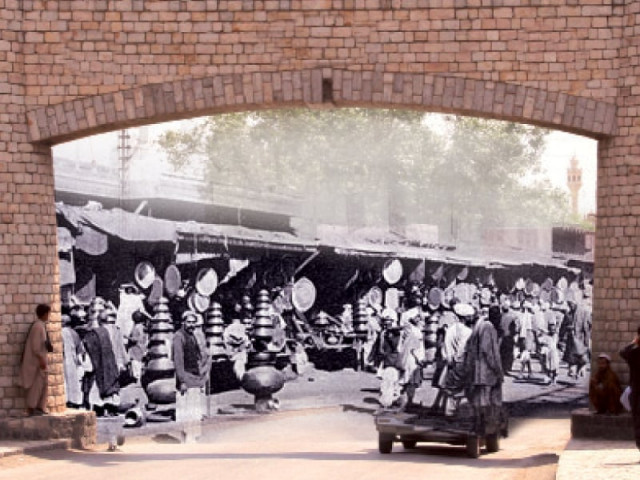Unlocking the past: Peeking through the gates of history
Unsuspecting residents pass through the Bara Gate unaware of its lost glory.

Unsuspecting residents pass through the Bara Gate unaware of its lost glory. ILLUSTRATION: ANAM HALEEM
For 80-year-old Jamal Din, although the Bara Gate symbolizes history, the passage of time has reduced it to little more than a memory – with nothing left to pass on to coming generations.
Also known as ‘Gate number 13’, the Bara Gate was erected by the British government in 1900 to guard their military installations inside the cantonment area from attacks by tribesmen.
The gate itself is not situated in Bara. Rather, it lies in Peshawar near Swati phatak area. The British government at the time also constructed other gates including Nothia Gate, Swati Phatak Gate and Dabgari Gate. These gates were all built for the same purpose, and surrounded the cantonment area. However, Bara Gate had greater importance than the others, as it punctuated the road passing through Bara on to Afghanistan, Tajikistan and Iran.
During the British Raj, only vehicles belonging to the British army used the gate to pass through to Bara. Now, thousands of vehicles pass through Bara Gate, which exists only in name, on a daily basis.
“During the 1965 war, in order to move heavy tanks from the cantonment area in a hurry either towards the eastern border of the country or to safety, the authorities pulled the gate down,” said Din, adding there is no physical remnant of the gate left.
“The gate was for the protection of the British government’s cantonment,” said Rahim Khan, another elder of the area. Khan revealed the gate used to be closed by 10pm for all traffic. “The gate was also reinforced by barbed wire to prevent entry from all directions.”
In order to restore the rich heritage associated with the British Raj, the government recently reconstructed several old gates in Peshawar including Kabuli Gate, Ganj Gate and Lahori Gate. However, Bara Gate has not been given attention as far as restoration is concerned.
Moreover, younger generations know little of the historical facts associated with the gate. “I have been passing through this gate since I was very young,” said Muneer Ahmad, 40. “I was surprised to learn it lies in Peshawar, as I always thought it was located in Bara.”
Although the municipal department has reconstructed Kabuli, Ganj and Lahori, Bara Gate lies out of its domain as protecting and maintaining heritage falls under the ambit of the culture and archaeology department.
Jamal Din believes the gate should be reconstructed to capture its historical significance. “If we want to protect our history, we have to reconstruct this gate in its original shape.”
Published in The Express Tribune, June 21st, 2013.













COMMENTS
Comments are moderated and generally will be posted if they are on-topic and not abusive.
For more information, please see our Comments FAQ